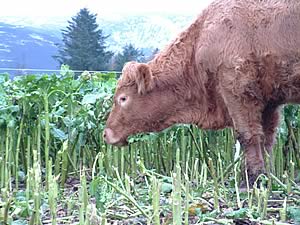12/05/06
Cattle producers considering out-wintering cattle on self-feed
brassicas can mitigate any cross-compliance concerns with
careful planning.
 |
| ‘With careful
planning, out-wintering cattle on kale need not give farmers
cross-compliance concerns.’ |
“Provided you do a proper field risk assessment
and take some simple practical steps, there’s no real barrier
to out-wintering cattle on many UK livestock farms,” points
out agronomist Simon Draper, contracted by Momenta to deliver cross-compliance
advice as part of a DEFRA-funded initiative.
“Cross-compliance is an imperative consideration – not
least so that your Single Farm Payment is not put in jeopardy – but
it shouldn’t be that much of an obstacle for all but a few
farms.”
Simon says that for best practice fields chosen for out-wintering
should not have an extreme slope. And if they are close to watercourses
or water supplies (eg. boreholes or springs) they should not be
used. “Having avoided the obvious likely problem fields,
it’s then important to choose land that dries out quickly.”
SAC beef specialist Gavin Hill agrees. SAC has been running an
out-wintering demonstration on Maris Kestrel kale – co-funded
by Quality Meat Scotland – at House O’ Muir Farm on
the Bush Estate, Penicuik. Important lessons have been learned,
and the key one is that for cows to out-winter successfully their
welfare and the prevailing environmental conditions must be key
considerations.
“Where soils are heavy and not very well draining, they will
poach easily,” Gavin points out. “This results in an
immediate welfare problem and difficulties with regeneration and
crop establishment, to say nothing for the impact on soil structure
and the environment.
Cows need a dry lie and also a degree of shelter to provide protection
during extreme weather conditions. It is advantageous to have two
runbacks, so that one can be used while the other is regenerating.”
Provided the cows are comfortable, it’s important to recognise
the positive health benefits of wintering stock outside. “Cattle
wintered outside in the right soil conditions appear contented
and healthy,” Gavin observes. “Reducing indoor stocking
definitely helps all round health and welfare – a particular
benefit being a reduction in pneumonia outbreaks.”
Having earmarked the right fields for out-wintering it’s
then a matter of setting the system up correctly. “We’ve
established that doing all your machinery work in the summer and
locating all the winter feed bales in the field prior to the cows
entering makes an enormous difference to soil run off. Damage to
the fields, especially around the gateways, was significantly reduced
by keeping tractors off the land during the winter,” Gavin
Hill says.
Once the brassica crop is established, Gavin Hill points out that
GAEC proposals highlight the need to avoid soil damage due to heavy
concentrations of stock around supplementary feeding areas. “This
can be overcome by strip grazing a kale crop and moving an electric
fence a metre a day – this allows the cattle to stand where
the crop has been grazed off previously.”
Simon Draper agrees. “Poaching, run off and water-logging
are all important cross compliance issues. You should also remember
to take them into account in your Soil Protection Review that must
be completed by 1st September 2006.”
 Early
Maturing OSR Offers Seven-Day Harvesting Advantage Early
Maturing OSR Offers Seven-Day Harvesting Advantage
 Outside
winter feeding on forage brassicas Outside
winter feeding on forage brassicas
 Extending the autumn grazing season with Kale Extending the autumn grazing season with Kale
|


